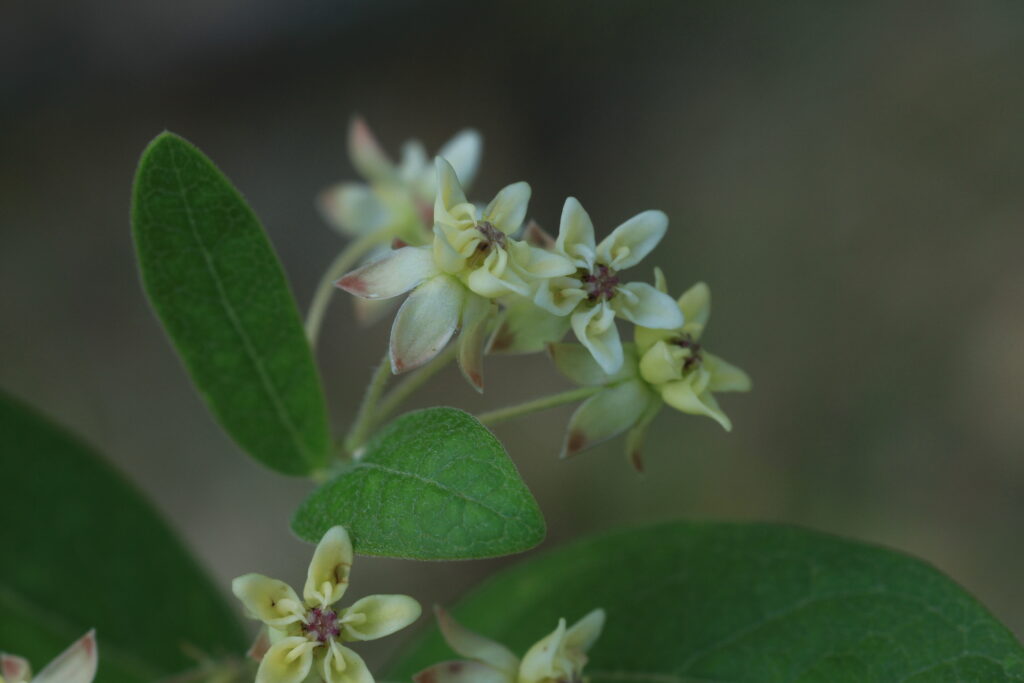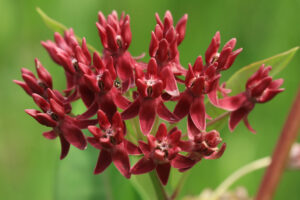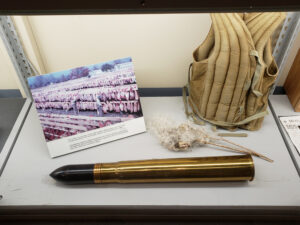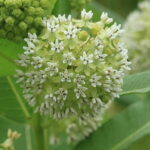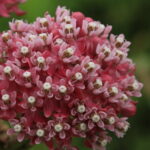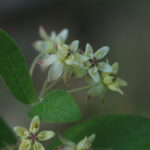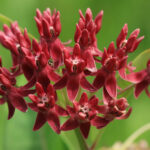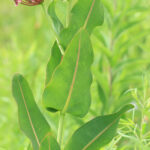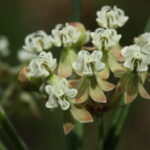Michigan has 11 species of milkweeds that are native to the state. How many have you seen? I would guess most people are familiar with at least three of the common species like Common, Swamp and Butterfly or Orange milkweed, but some of the rarest are the most beautiful to see. Last week I traveled about 1300 miles round trips to find the last three species to complete my list of our native Asclepias species. Was it worth it? You bet!
On Tuesday I visited Menominee to find the endangered Dwarf or Oval leaf milkweed. I could see Wisconsin across the river form near where these little gems grow. Asclepias ovalifolia is a western species and is only known from one county in the Upper Peninsula in Michigan. They are found in a savanna which also has a small stand of Porcupine grass, June grass and some Frost weed. Common milkweed was also in the savanna and Marsh milkweed was on the river bank nearby. Dwarf milkweed is a cute little plant with creamy white flowers with a tinge of dark pink on the lower petal tips.
For several years I have spent the day on July 4th visiting the great American landscape, prairies. This year was no exception. On Saturday I traveled to Algonac State Park near Port Huron for the last two species of Asclepias that I was searching for. As you drive along the front of the park, you can see Canada across the river. A short distance into the prairie that is in the park, the threatened Asclepias sullivantii was right on the edge of the path. What gorgeous flowers and an interesting leaf with its prominent mid vein. The flowers somewhat resemble those of Common milkweed but the petals are a bit longer, the flowers are larger and a nice pink color. The top of the flower is also more closed than Common milkweed. A. sullivantii is only know from five counties in Michigan. It is a much taller and showier plant than I expected.
In the same prairie as A. sullivanti was a milkweed that I have been searching for, for many years. After finding the threatened Asclepias purpurascens and comparing pictures from five years ago, I realized I had indeed seen this beauty before. But now I am sure and have much better photos of it. Purple milkweed is a beautiful showy species that on average is a smaller plant than I had imagined. The intensity of the purple flowers makes it easy to see form a distance if it is sticking up above the other vegetation. While A. purpurascens can be found in the same moist prairies as A. sullivanti, it can also be found in dry savannas. The intensity of the purple can vary but the outward curling of the pointed lower petals makes this quit a showy flower.
Other species of milkweeds found in dry sandy prairies in Michigan include Clasping milkweed (Asclepias amplexicaulis), Butterflyweed (Asclepias tuberosa), Whorled milkweed (Asclepias verticillate) and Green Milkweed (Asclepias viridiflora). Common milkweed (Asclepias syriaca) is found in a variety of conditions and is common in old fields and roadsides. The threatened Prairie or Tall Green milkweed (Asclepias hirtella ) is found in both moist and dry open situations. Lastly, Poke milkweed (Asclepias exaltata) is our only true forest understory Asclepias. It is easily recognized with its loose clusters of white flowers along forest openings where it can get a bit of sun light.
Milkweeds are the only host plant for Monarch butterfly larvae, with Common and Swamp being the most favored for egg laying. While Monarchs will use any milkweed species, these two are the ones most often used in Michigan with the orange Butterflyweed being third on the list according to my nearly 50 years of observations. Many species of butterflies also nectar on the flowers of milkweeds. On a good year, Butterflyweed is alive with an abundance of feeding butterflies when in bloom in early to mid-July.
There are also uses for the fibers from this plant, which is considered by many to be just a weed. Research has been done on using the plant for paper, textiles, lubricant, fuel and rubber. Currently the most used part or by product of the plant is the silky white floss attached to the seeds. The purpose for this floss is to carry the seeds away to a new location by “floating” on the wind. This floss is hollow and six times more buoyant than cork. This light weight floss has been used to stuff pillows, mattresses and quilts and as tinder to start fires. During World War II, it was collected and used to stuff life vest for Navy aviators.
Next time you see a milkweed, take time to look it over and study the details. If you find a patch of Common milkweed, enjoy the beautiful fragrance which can often be detected before you even see the milkweeds.
- Butterfly Milkweed
- Clasping Milkweed
- Common Milkweed White Form
- Common Milkweed
- Dwarf Milkweed
- Green Milkweed
- Michigan History Museum Display
- Poke Milkweed
- Purple Milkweed
- Sullivants Milkweed plant
- Sullivants Milkweed
- Tall Green Milkweed
- Whorled Milkweed
 Click on the title of a post to view a full gallery of images.
Click on the title of a post to view a full gallery of images.
